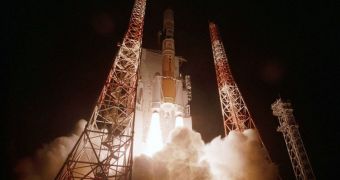On Friday, September 23, the Japan Aerospace Exploration Agency (JAXA) managed to launch a new spy satellite to Earth's orbit. The successful maneuver marked another expansion in the Asian nation's orbital capabilities, which are already rather extensive.
One of the primary uses Japanese spy satellite have is to keep tabs on what goes on in North Korea, a country widely suspected of being involved in illegal nuclear weapon development operations.
Japan has a large constellation of satellites in place to monitor all traces of suspicious activity coming from the nearby country. The new probe was launched aboard the same H-2A delivery system that acts as the backbone of JAXA operations.
For the new launch, the agency used its Tanegashima Space Center (TSC), the primary space launch installation it operates. Launch occurred at 0436 GMT (12:36 am EDT, 1:36 pm local time), and saw the 174-foot-tall (53-meter-tall) rocket take off and deliver its payload flawlessly.
The H-2A rocket features a two-stage design, whose lifting capabilities are augmented by twin solid rocket boosters (SRB), similar to what the American space agency used on its space shuttle's external fuel tank.
According to the scarce data JAXA made available on the satellite, the Mitsubishi Electric Corp.-built vehicle is now inserted in a Sun-synchronous orbit around our planet, which sees it flying at altitudes of about 300 miles (480 kilometers).
In addition to advanced optical cameras designed to scan every inch of any target area, the vehicle is also reported to carry an advanced telescope, capable of providing relevant data for applications such as intelligence gathering, remote sensing and civilian support.
This advanced space-based reconnaissance program JAXA and the Japanese government operate is a response to the test firing of a North Korean missile over the country's territory, back in 1998. Tokyo vowed never to be caught off-guard again, Spaceflight Now reports
According to JAXA's flight manifest, this was only the second launch to occur from Japan this year. The first was the flight the H-II Transfer Vehicle (HTV), an autonomous cargo delivery spacecraft certified to resupply the International Space Station (ISS).

 14 DAY TRIAL //
14 DAY TRIAL //